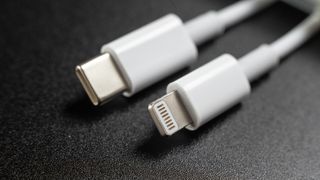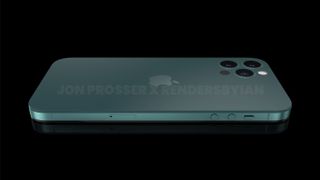If the iPhone 14 doesn't get this upgrade it will be a disaster
Without this feature I'll leave Apple for Android

As a long-time Android user I could merrily go through life without giving a damn about what type of charger I’m carrying with me. If I have a USB-C charger or cable, I’m pretty much golden. But after switching from Android to iPhone some three months ago, that wild abandon has been thoroughly torpedoed.
That’s thanks to Apple deciding to stick with the Lightning connection for the iPhone 13 Pro, my current daily phone, rather than adopt USB-C like it’s done with most of its other products — let’s not talk about the standard iPad or AirPods Pro.
So where once I’d waltz to the nearest London Underground station with a skip in my step listening to the birds chirping, sun beaming from between the Britain's moist clouds, now that same walk is one of dark paranoia and resentment, with my mind shuffling its gray matter in an effort to remember if I’ve grabbed a Lightning cable before rushing out of my apartment.
And you know what? I’m sick of that. I’ve embraced the Apple ecosystem, I’ve accepted the lack of customization to iOS and the walled garden approach to the App Store in favor of a slick and easy smartphone experience. But I’m angry and confused at the Lightning port position Apple can’t seem to let go of. So much so that if this doesn't change with the iPhone 14, I’ll potentially move back to Android.
iPhone 14 must embrace USB-C

USB-C connectivity for iPhones has been rumored for a while, and having skipped the iPhone 13, we’re now hoping it’ll pop up for the iPhone 14 or at least the iPhone 14 Pro.
The iPhone 13 range comes with a cable that’s USB-C to Lightning. Surely, Apple could just make both ends USB-C and be done with it.
The most obvious reason is it would give the next iPhone range a port that’s now synonymous with pretty much most of the iPhone 13 range comes with a cable that’s USB-C to Lightning! Surely, Apple could just make both ends USB-C and be done with it...our picks for the best phones, as well as the best laptops. And that means carrying around one charger to charge all your mobile devices. That also means cutting down on the need for custom cables and charging bricks.
Sure, different devices use different charging standards; the Google Pixel 6 Pro’s USB-C PD doesn't play nice with the OnePlus 9 Pro’s Warp Charge system. But at a push most USB-C chargers will at least juice up a phone or tablet over time.
What’s quite frustrating with Apple’s Lightning port approach is that the iPhone 13 range comes with a cable that’s USB-C to Lightning! Surely, Apple could just make both ends USB-C and be done with it...
I get there are plenty of Lightning port accessories out there. But I’m not convinced there are prolific numbers of people using them, especially now that many of the best headphones or best noise-cancelling earbuds are wireless. I also understand that Apple may not have any clear motivation to ditch the Lightning port, as doing so doesn't really serve it and Apple fans will likely flock to the next iPhone regardless.
But if Apple is going to preach to us about being environmentally friendly and promote recycling, as well as not put a charging brick in the iPhone box, then it feels to me that the next step of responsibility would be to adopt a form of universal charger. After all that’s what the European Commission is pushing for. Meaning Apple might have to adopt USB-C regardless if it wants to stay in that market.
Add in the fact that USB-C is the prominent port on the new MacBook Pros, the iPad Air, iPad mini and iPad Pro, and it’s not like Apple isn’t used to switching to USB-C.
The potential of USB-C and iPhone 14

Even if I gloss over the convenience and logic of an iPhone with a USB-C port, I also think it makes a lot of sense when it comes to opening up new and interesting features for an iPhone 14, especially the Pro version.
The data transfer speed of a Lightning cable is 480 Mbps, while USB-C cables can hit 40 Gbps, and as a result can support more high-end peripherals than Lightning. We’ve seen this with the iPad Pro, as it can use USB-C to connect to ultra high resolution displays, as well as act as an editing suite for photos and videos with the ability to suck files from DSLRs and other sources.
While the iPad Pro is targeted at such creative work, I see no reason why an iPhone 14 Pro or 14 Pro Max couldn't be used in the same way; this is especially true for the the Max as it’s likely to have a similar 6.7-inch display as the iPhone 13 Pro Max.
I’d love the idea of snapping some photos on my DSLR and then editing them on the fly using the capable apps and tools iOS 15 has access to. Furthermore, I could then splice photos and footage with those captured on the iPhone, thereby giving me a bit of a creative suite in the palm of my hands. Or alternatively, I could back up ProRAW photos or simply a mass of iPhone snaps and videos onto a high-capacity external SSD, thereby giving me an extra layer of redundancy if iCloud or Google Photos goes down.
It may be wishful thinking, but the only reason I cloud see Apple blocking this is to force people to get the iPad Air or iPad Pro to go alongside an iPhone. And it’s that cynical thinking that has me balking more at Apple’s Lightning port use.
In short, if Apple doesn’t embrace USB-C for the iPhone 14, I’ll not only see that as a bit of an insult to consumers, but also a move by Cupertino to turn its back on iPhone potential. I really hope that’s not the case, but I and you, dear readers, will have to wait until the fall before we see what’s next for the iPhone.
Sign up to get the BEST of Tom’s Guide direct to your inbox.
Upgrade your life with a daily dose of the biggest tech news, lifestyle hacks and our curated analysis. Be the first to know about cutting-edge gadgets and the hottest deals.
Roland Moore-Colyer a Managing Editor at Tom’s Guide with a focus on news, features and opinion articles. He often writes about gaming, phones, laptops and other bits of hardware; he’s also got an interest in cars. When not at his desk Roland can be found wandering around London, often with a look of curiosity on his face.

